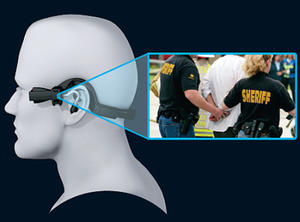Law-enforcement technologyTaser rolls out redesigned wearable cameras
Last week Taser, the manufacturers of the electric stun guns, unveiled its newly remodeled wearable camera system which is sleeker and more advanced than its predecessor; the Axon Flex, introduced less than a year after the company rolled out its first wearable cameras, represents a significant upgrade

Mannequin wearing the AXON with a sample image captured by the camera // Source: swmadrid.es
Last week Taser, the manufacturers of the electric stun guns, unveiled its newly remodeled wearable camera system which is sleeker and more advanced than its predecessor.
The Axon Flex, introduced less than a year after the company rolled out its first wearable cameras, represents a significant upgrade. Taser’s first cameras, the Axon, were deemed dorky, uncomfortable, and too bulky, featuring a large 5.6-inch hand-held viewer.
“It was too clunky, too early,” said Patrick Smith, the CEO of Taser, in an interview with VentureBeat.
Starting over from scratch, the company listened extensively to comments from the law enforcement community, and rather than building the system itself, decided to outsource it to reliable partners.
Taser began with the camera’s fit. Officers said the camera’s head mount was uncomfortable and looked awkward. “Our headgear was slightly more comfortable than braces,” Smith said.
The company’s survey found that 90 percent of officers liked the look of Oakley-brand sunglasses, so Taser opted to mount the Axon Flex’s camera to a pair of custom Oakley Flack Jacket glasses via magnets.
As for the camera itself, Taser chose to partner with Looxcie, a firm which manufactures small, wearable cameras that stream data using Bluetooth.
Opting to abandon the bulky video viewer, Taser focused on integrating its technology with smartphones. To that end, the company created mobile apps for Android and iOS smartphones and tablets.
With the mobile app, officers can preview, name, and add notes to the video, but cannot download any of the data, which is stored on the camera’s 8GB of internal memory, to ensure that evidence is not tampered with.
Taser is also working to develop another mobile app, dubbed Evidence Mobile, which collects digital evidence from a crime scene including audio notes, geo tags, and photos.
Finally, to archive all the collected data from officers’ cameras, Taser teamed with Amazon Web Services to create Evidence.com a cloud-based storage system. Instead of relying on DVDs, physical hard drives, or other storage solutions, the cloud allows multiple individuals to view footage at any given time from Evidence.com’s remote servers.
The embattled Bay Area Rapid Transit (BART) police will be the first law enforcement agency to try out the new Axon Flex camera system when they receive 150 of them at the end of the month. In recent years, BART police have been embroiled in controversy following the fatal shooting of two passengers in separate incidents.
